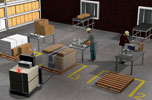

The operator of a major water park in the USA had to monitor the water level in its tank for a performing whale, a critical factor in keeping the beast healthy. Unfortunately the cable from the level sensor ran for about 3 m beneath a heavily travelled public walk that was regularly drenched by the splashing whale. When the cable failed, which was frequently, it had to be dug up and replaced, inconveniencing the public and adding to operational costs. Eventually, a manager got the bright idea to use wireless modules to send data about 6 metres, and walkway excavations stopped.
Anecdotes such as these make people aware that wireless technology, which is frequently used in factories and other industrial settings where I/Os must be sent from a remote area to an operator located several kilometres away, can also make sense if data only has to travel a few metres.
Wireless traditionally has been thought of as a way to send signals 1 to 5 kilometres. But it also provides advantages in short-distance applications. For example, plant floors commonly have hazards and obstructions, so companies must buy and install more cable than they would need to go around them. An alternative, running cable beneath the plant floor, calls for new construction and significant downtime.
Cables can also pose a logistical nightmare in applications involving rotating machinery, heavy equipment, and hazardous conditions. In these situations, wireless sensors provide simpler installation and maintenance, and a convenient, reliable way to keep operations running smoothly without the risk of signal loss from damaged cables.

Wireless networks use a pair of transceivers: a node to gather system data and a gateway controller to concentrate collected information. These transceivers are relatively small and easy to mount throughout a plant, making them particularly convenient for short distance applications.
For more reliability, the Sure-Cross wireless network from Banner Engineering features deterministic responses, letting it work even if RF communication is unexpectedly obstructed. When a Sure-Cross network is used, wireless transceivers can be configured to respond to signal losses in one of several ways: it can sound an alarm, freeze at the last value recorded, or default to a ‘safe’ mode.
One reason wireless has not typically been considered in short distance applications is its susceptibility to signal interference. Welding, forklift operation, moving machinery, and other obstructions common in plants, as well as weather, can degrade wireless communications. Plus, when two radios are close to each other (generally less than 2 m apart), there is a high risk they will interfere with each other. In addition, if there are other signals on the same frequency, such as at 2,4 GHz, which can be used for transceivers and microwaves, the signal will likely be obstructed. But networks now offer several features to help ensure reliable communications and signal strength in these challenging cases.
Frequency hopping spread spectrum (FHSS), for example, helps transceivers successfully deliver I/O despite competing signals from other devices. FHSS lets a wireless signal switch between different frequency channels in a pattern recognised solely by the transceivers assigned to communicate with one another. This technology is particularly well suited for sending small, redundant packets of data in a high interference environment. Devices can also be equipped with remote antennas, letting radios be mounted close to one another but sending and receiving signals via antennas mounted above any obstructions or interference.
In addition, a network ID function lets transceivers differentiate themselves from others nearby. With this function, a gateway can observe other devices operating on the same frequency and, in response, shift its pattern to decrease the risk of interference. To further avoid interference with other radios, several nodes can be configured to communicate with a single gateway located several hundred metres away. This lets one ‘brain’ monitor and control several machines at once within the same area, making it easier to manage the plant.
To combat signal interference caused by environmental obstructions, including plant operations and weather, companies carry out site surveys to verify and evaluate wireless signal status. It lets users determine the signal strength of their networks and identify locations that suffer from the most interference. This information can be used to improve I/O transmission by adjusting locations. In many cases, simply placing a module as little as 1 m above the obstruction can make the difference between frequent signal failure and good communications. Banner wireless devices have embedded site survey capabilities, letting users conduct surveys with no additional software, personnel, or hardware.
Using wires to control conveyors, transfer presses or overhead cranes is often inefficient and ineffective. Although the I/O only needs to travel a short distance, nearly all cabling used must be able to flex rapidly, sometimes up to 50 times a second. High-flex cable is expensive and cannot be guaranteed to last in particularly challenging applications. Plus, cabling is extremely difficult to install, especially for overhead installations. Wireless networks provide a convenient alternative solution. By using a battery-powered node on the rotating equipment and a gateway at a control panel anywhere from 3 to 60 m away, a wireless network eliminates the need for high-flex, difficult-to-run cables or costly slip rings.
Simple installation, reliable operation, and sophisticated communications have made wireless a sensible choice, bridging the gap between a process and its operator. Today, thinking of wireless in terms of kilometres merely scratches the surface of its capabilities.
For more information contact Rodney Topham, RET Automation, +27 (0)11 453 2468, [email protected], www.retautomation.com
| Tel: | +27 11 453 2468 |
| Email: | [email protected] |
| www: | www.turckbanner.co.za |
| Articles: | More information and articles about Turck Banner Southern Africa |

© Technews Publishing (Pty) Ltd | All Rights Reserved